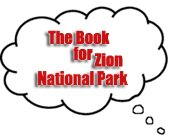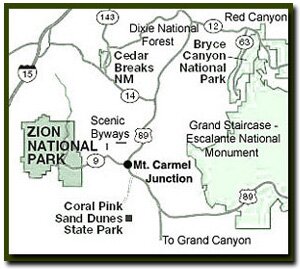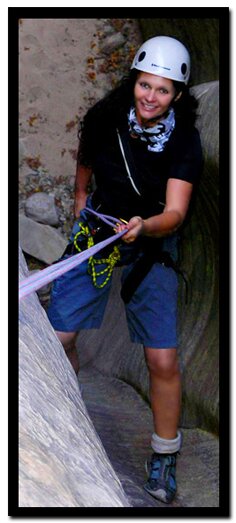 |
||||
|
Zion National Park Lodging Park Info Vacation Weather Photos Hike SR-9 Slots Backpack Camping |
||||
Zion: Mystery CanyonMystery Canyon is a relatively known canyon in Zion National Park that is sought after by many canyoneers but only twelve hikers per day are allowed to venture within. For this reason, the canyon shows relatively low impact compared to some others such as the Zion Narrows, Orderville Canyon and Subway. The route begins down a slippery slope, then drops through a beautiful slot canyon section. When it opens up, it's into a spring with nice vegetation around charming pools. The end is a spectacular rappel through the first waterfall in the Zion Narrows. Mystery Canyon is a canyon requires good physical conditioning and takes a full day for most. Technical canyoneering gear includes 140' of rope and a pull cord of equal length, or two -140' ropes, harness and descending equipment, emergency ascending equipment, emergency overnight gear and plenty of water. Although this tight narrow canyon with a spectacular grand finale rappel into the Zion Narrows is truly a mysterious canyon the name was given because the source of the falls were a mystery . Canyoneers can choose to set-up a shuttle, taking one vehicle to the East Rim of the park and leaving another where it can be accessed from Zion Canyon or you can start at the Weeping Rock Trailhead and hike the more demanding path up the East Rim Trail dropping into Mystery Canyon just short of Observation Point.
Southern Utah Flash Flood info. Never enter a technical canyon without the knowledge and skills needed to safely explore and return. Rappelling and down-climbing skills are required to navigate through Mystery Canyon. Do not jump. Jumping in Zion's canyons have resulting in many broken bones. Many technical canyons, such as Mystery Canyon, also require excellent map reading skills to navigate.
East Mesa Trailhead - From the east gate of Zion National Park, drive 2.4 miles and turn at the junction of the North Fork Road and SR-9. Drive 5.2 miles up the road to the Ponderosa Ranch. Turn left at the Ponderosa Ranch under the black arched sign. Travel .7 miles then turn right at the intersection on the Twin Knolls Road. At 1.45 miles turn right at the intersection. Follow the well traveled dirt road which will eventually become a high clearance or 4WD road at approximately 2.4 miles. The Observation Point sign is at 2.6 miles. Stay right as the road begins to descend a rocky hill then levels out. At 2.85 miles there is a "Y" intersection. Turn left and drive .1 miles to the gate at the East Mesa Trailhead. Park here. East Mesa Trail to Mystery Canyon - Pass through the hikers gate and into Zion National Park. Begin hiking the East Mesa Trail, which is an old road (was once a jeep road) with easy, slightly uphill traveling. The trail meanders through manzanitas, gamble oak, wild roses, ponderosa, pinion, mountain daises and Indian paintbrush (bring bug repellant). After about a mile of hiking, the road narrows to a narrow hiking path. Juniper trees appear and the trail begins to level off. The East Mesa Trail gets slightly steeper and yields a view (to your right side) of the head of Mystery Canyon.
East Mesa Trailhead Mystery Canyon Trailhead Observation Point Trailhead Option - The trailhead can be accessed from one of two directions: The hike from the Weeping Rock parking lot up the East Rim Trail, onto the East Mesa Trail and bypassing Observation Point, which will add a couple hours and lots of elevation gain to the overall hike, but eliminates the need for a drop-off or car shuttle to the East Mesa Trailhead. The other approach is done form the east side of the park at the East Mesa Trailhead which then requires a car shuttle. East Mesa Trailhead - Pass through the hikers gate and into Zion National Park. Begin hiking the East Mesa Trail, which is an old road with easy, slightly uphill traveling. The trail meanders through manzanitas, gamble oak, wild roses, ponderosa, pinion, mountain daises and Indian paintbrush. (bring bug repellant for this section). After about a mile of hiking the trail narrows to a hiking path. Juniper trees appear and the trail begins to level off. At 2.5 miles (about 45 minutes to 1 hour hiking) on the East Mesa Trail, the top of Mystery Canyon will be found. The East Mesa Trail gets slightly steeper and yields a view (to your right side) of the head of Mystery Canyon. Its extremely important to make sure you are in Mystery Canyon and not another side canyon. There may be a cairn on the right that will lead you through the scrub about 30' to the edge of a steep descent at the head of Mystery Canyon. Descent into Mystery Canyon - At this point notice a fairly prominent trail that traverses to the right, going across a steep scree slope heading toward some thicker vegetation on the right and downhill. Follow the trail down the slope which will eventually become a drainage . During the half-mile descent the trail looses nearly 1000 ' of elevation on the way to the canyon floor. There might be some bushwhacking but do count on a steep, dirt and rock, slippery shale approach. On wet years rock slides and water flow disturb this section of the trail changing it rapidly. Soon there will a more gradual descent with several dry fall obstacles that may or may not be passable without the use of ropes . Follow the Mystery wash for the next half-mile as canyon walls grow higher on both sides and a few sections become enclosed with cliffs on both sides. A favorite spot in the canyon is a tall slab of slickrock on the right showing stains of waterfalls during rainy periods. Soon is a sharp turn to the left and the canyon turns from a relatively open wash to a slotted, fluted narrow passage. Just around the corner is the first rappel with bolt anchors on the left wall. Rappelling skills are required to navigate through Mystery Canyon. Remember slot canyons can change dramatically in a short time due to flash floods and water levels in this canyon change. These directions are only a general reference. Be prepared for variations in the canyon. First Rappel - This rappel is approximately 50' and will indicate the point of no turning back once at the bottom of this absolutely gorgeous section of Mystery Canyon.
Third Rappel - Continuing down the uniquely fluted slot section of Mystery Canyon, another, the third rappel presents itself just a short distance further. The anchors on the left side will enable canyoneers to descend 40' again to the canyon floor. Forth Rappel - Again just a short distance down canyon is the fourth short rappel of 15' done by using the anchors on the right. Fifth Rappel - Now left with one last rappel to do until the canyon walls spread open and show a glimpse of the suns rays. The fifth rappel will be done using anchors on the left face, and will take you down and around the corner to the left as you face down stream. As you walk the walls slant back and away, giving the option of staying in the constricted narrow passage for two more fun rappels or choose to scramble up the steep slab of rock on the right and then bushwhack around the north side of the slotted section. This alternative is steep, dangerous and not the best choice. Its recommended staying in the watercourse which is safer and helps prevent erosion. Sixth - Seventh Rappels - After negotiating the final 2 rappels in the narrow passage, work your way down canyon, trying to remain in the watercourse. There are a couple of places that the trail will push you up and to the right bypassing some dry fall's. Once again if anchor opportunities present themselves you should try to remain in the floor of the canyon. (More possible short rappels in this section to stay in the watercourse) A short distance down canyon is Landslide Lake. This lake has been full enough at times that it may be necessary to swim 100 meters or it may be dry and an easy walk to the opposite bank. Currently, working your way up the right side of this dam seems to be the easiest route of travel up and over the large rock fall - landslide dam. Once up and over the dam, traveling down canyon will require some route finding to negotiate a couple of dry fall's. This may require some short downclimbs including a short log walk. Eighth Rappel - Bolts on a low angle slab provide an anchor for a 35' rappel. Walking down-canyon soon presents a long walk down a log wedged in the watercourse. Mystery Springs At the bottom of the log walk a fun slickrock slide will deposit you at near the anchors for the second to last rappel into Mystery Spring. If you are talented you can probably avoid getting wet. Ninth Rappel - The anchors are to the left, on a sloping ledge approximately 40' out and only one person at a time should go to the anchors since the space is minimal. This rappel is approximately 135' and it's a bit awkward. The rappel will take you to a large boulder - chock-stone jammed in the slot below. The tendency is to try to traverse to your right (as you are facing in to the cliff) but let gravity take you to the chock-stone, then continue off the rock toward the spring below through the chimney - slot (on your right as you face the cliff you have descended). The spring will be the first flowing water you will encounter during the hike, and is also an indication that there is one rappel remaining to the Zion Narrows. Tenth Rappel - Just down stream from the spring you will encounter a few downclimbs in the lush flowing streambed, and you may want to anchor a handline - rappel from the tree set back 30' from the edge of a 10' drop into the wash below. Eleventh Rappel - - After this 10' rappel - downclimb it is a short 150 meters before you will be looking down into the magnificent view of the Zion Narrows and the waterfall that you will rappel the last 130' until the short .25 mile hike for the paved path Riverside Walk to Riverside Walk . Riverside Walk - This is a mile long hike on a pleasant and sometimes very crowded paved path that puts hikers at the Temple of Sinawava parking area. Add a twenty minute ride on the Zion Canyon Shuttle to Canyon Junction where you have probably stationed your shuttle vehicle, then retrieve your vehicle stationed at the East Mesa trailhead. One mile hiking on a pleasant and sometimes very crowded paved path puts hikers at the Temple of Sinawava parking area. Add a twenty minute ride on the Zion Canyon Shuttle to Canyon Junction where you have probably stationed your shuttle vehicle, then retrieve your vehicle stationed at the East Mesa trailhead. Alternate Start - Begin at the Weeping Rock parking lot and hike up the Observation Point Trail. Take the signed fork at the top to the East Mesa Trail. Drop into Mystery Canyon at the following coordinates. History - Mystery Canyon got its name because the bottom and middle of the canyon is blocked by falls, thus it was a mystery as to what was below. I say "was" because the canyon was named prior to the 1960's when early canyoneers made their way to the bottom and put an end to the mystery. GPS coordinates are only references and may or may not be accurate. Do not rely on GPS coordinates as the sole method of navigation. Always have an accurate, detailed map at hand and have the proper map reading and navigation skills before setting out on any hike. Many of the hikes listed in this guide travel into canyons where a GPS has limited capabilities. Always check your position with a detailed map before dropping into a canyon. Beta: Coordinates and other trail and canyoneering information by Zion Park search and rescue veteran team member Bo Beck and zionnational-park.com author Mary Cisneros. To post trip reports, offer corrections, updates, or for more information please visit the Zion National Park Forum Suggested Gear: A sturdy pair of shoes are recommend to hike the trails in Zion National Park. Many quality shoes will help grip the rocks and prevent injury.
Zion National Park, UtahHistory of the Thunderbird |
East Zion Lodge Mileage from Stay in a hotel the heart of the parks, Mount Carmel Junction, and visit the treasures of the Southwest and Utah. Site Map Zion Hiking |
||||||||||||
|
This is my new favorite quote:
"I don't know who Mary Cisneros is, but I mean zionnational-park.com It's a better site than the NPS's anyway." Written by the authors of the book: Favorite Hikes in and around Zion National Park |
|||||||||||||
|
Zion History |
|---|
All rights reserved © Copyright Zion National-Park dot com
Do not use text, photos or maps without permission © Zion National-Park dot com
Contact the Author Mary Cisneros with any errors


 Mystery Canyon is a relatively known canyon in Zion National Park that is sought after by many a "canyoneer" but only twelve hikers per day are allowed to venture within. For this reason, the canyon shows relatively low impact compared to some others such as the
Mystery Canyon is a relatively known canyon in Zion National Park that is sought after by many a "canyoneer" but only twelve hikers per day are allowed to venture within. For this reason, the canyon shows relatively low impact compared to some others such as the 


 GPS Coordinates WGS84 Datum
GPS Coordinates WGS84 Datum
